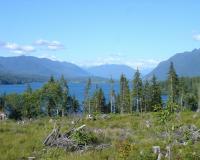
Vibrant Environment
Climate Change And Sustainability
All | Biodiversity | Climate Change and Sustainability | Environmental Justice | Governance and Rule of Law | Land Use and Natural Resources | Oceans and Coasts | Pollution Control

Tribal nations have been leading the way in climate change adaptation planning long before local governments even got started.

According to a 2020 report published in Nature, up to 20 percent of the global carbon budget could be consumed by construction over the next 30 years.

I encountered an induction cooktop for the first time recently, and my life has never been the same. Boiling water, which usually bores me to tears, took half as much time as it did on a gas stove. Garlic sizzled in seconds; broccoli softened in a minute or two. With a press of the on button, I sped up time itself, whizzing through a recipe that would take me an hour on a traditional electric stove, 45 minutes on a gas cooktop.

The COVID-19 pandemic has exposed and exacerbated inequities that lead to differences in health outcomes, particularly for racial and ethnic minority groups. One community that has been particularly affected is the Pacific Islander community in the United States, which has experienced exceedingly high rates of infection, hospitalization, and morbidity.


For the last several decades, many leading businesses have expressed support for climate policy in the United States. While there are many businesses that expressed concerns and even advocated for policies back into the late 1990s, here I will trace efforts back to 2006. That was the year the U.S. Climate Action Partnership (USCAP) was initiated. The USCAP was a collaboration between leading businesses and climate-focused NGOs. Its goal was to develop consensus policy recommendations and principles for Congress and the new executive administration that would be elected in 2008.

The climate emergency is here, and the only way to stop the downward slide to chaos is to cut methane and other super climate pollutants as fast as possible, while also dramatically reducing carbon dioxide emissions. One message has been made clear by the United Nations Environment Programme and Climate and Clean Air Coalition’s Global Methane Assessment, and the IPCC’s Sixth Assessment reports: Cut methane now or doom the planet.

The Intergovernmental Panel on Climate Change’s (IPCC’s) latest reports do not bode well. The 2021 Physical Science Report, for example, emphasizes as its primary conclusion that “[i]t is unequivocal that human influence has warmed the atmosphere, ocean, and land.” The global average surface temperature increase since 1850 is about 1.07 degrees Celsius (1.93 degrees Fahrenheit), driven by anthropogenic greenhouse gas emissions.

Cities, the U.S. military, and private businesses are increasingly turning to artificial intelligence and analytical tools as they strive for greater resiliency amid growing incidents of climate-related flooding, heat waves, and other extreme events. In January, participants in the Environmental Law Institute’s 9th GreenTech webinar—“Technology and Climate Resiliency”—discussed these developments and the incentives for adoption of cutting-edge tools and various impediments.

Part III of this four-part blog series discussed common shortcomings to avoid in developing climate plans and examined two instances of legal challenges to county plans in California.